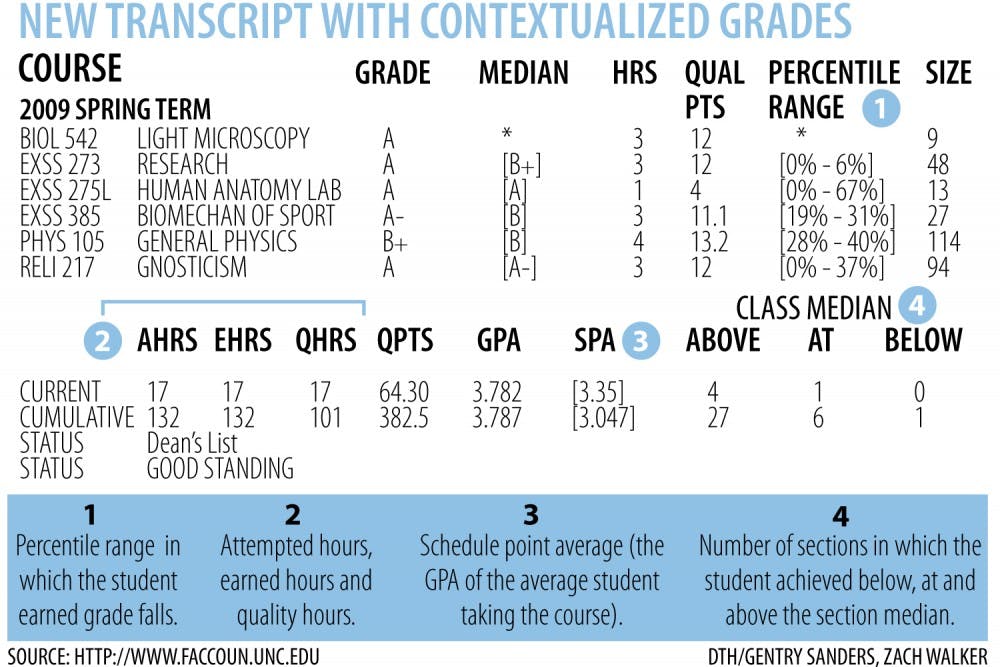“Faculty began being concerned that the mechanism for student feedback on classes was driving up grades and leading to grade inflation,” Villemain said.
The decades that followed brought increased attention to grade inflation, annual reports on grade patterns and differing interpretations of the causes and severity of grade inflation at UNC.
More than 30 years after the initial questions of grade patterns, Perrin’s 2009 final report reasserted that grade inflation, compression and inequality existed at UNC, and that they needed to be addressed.
The solution that came out of the 2009 report was the contextualized grading proposal that faces student government and the faculty council today, but it won’t be the first time UNC has discussed the proposal.
Not behind the scenes
Holly Edington, 2010-11 student body vice president, said she inherited contextualized grading from her predecessor, David Bevevino, and continued the discussion.
“It wasn’t something we were doing in the dark, behind the scenes,” Edington said. “We spent a lot of time talking with faculty.”
Edington said her administration vetted the idea with student focus groups and reviewed mock-ups of the future transcripts.
“At that time, there was a good amount of student and faculty support,” Edington said. “But we knew that there needed to be time to get everyone used to the idea.”
So implementation was intentionally delayed, she said.
Perrin said that in fact, the resolution was originally intended to take effect in the fall of 2012, but the introduction of ConnectCarolina and then the Wainstein Report caused delays.
By the time the University was ready to roll out the new transcripts, there was a completely new student body, many of whom hadn’t ever heard of the proposal.
To get the day's news and headlines in your inbox each morning, sign up for our email newsletters.
“There was this other new set of concerns from some members of student government that they sort of didn’t understand it, or felt they hadn’t been consulted enough on it,” Perrin said.
A new page
Karthik Sundaram, the undergraduate representative on the Educational Policy Committee, said the group will spend this semester reviewing the now 5-year-old policy.
In looking forward, Sundaram said, the committee will take into account conversations of the past.
“We don’t want to turn over the same stones,” he said. “One of the biggest components that was missing from before actually is feedback from employers and grad schools.”
Edington and Bevevino said students’ biggest concern was the potential impacts contextualized grades will have on post-graduate opportunities.
“As you talk about contextualized grading ... you get students worried about, will my good work be recognized the way it should?” Bevevino said.
A lack of feedback from professionals continues to be one of the biggest concerns among students, Villemain said.
“We hadn’t put this transcript in front of anyone who reads transcripts for a living,” Villemain said. “As soon as students were hearing that, they were pretty freaked.”
While Perrin said mock-ups of the new contextualized transcripts were not shown to employers in 2010, they were in fact shown to admissions officers at graduate schools.
“That was the piece that we were most attentive to,” Perrin said. “Any of the professional schools really understand this because they already do it.”
A changing University
“We are in a different place than we were in 2010,” Villemain said. “Making sure that grading is fair and that our classes have academic integrity, especially right now, that’s hugely important.”
The post-Wainstein era tells professors that there’s danger in high grades, Villemain said, and contextualized grading is reinforcing that message.
“It’s coming at an interesting time, because we are now associating clustered grades as extremely dangerous,” he said.
“The other question is, is this still the right policy for a new University?”
university@dailytarheel.com



